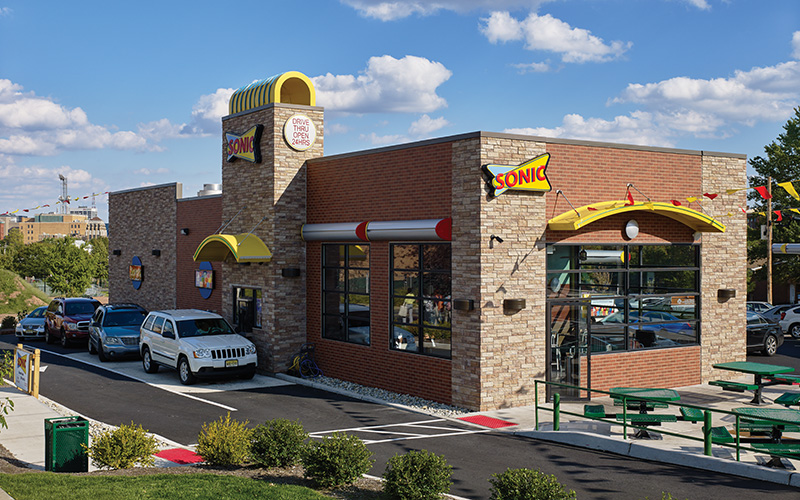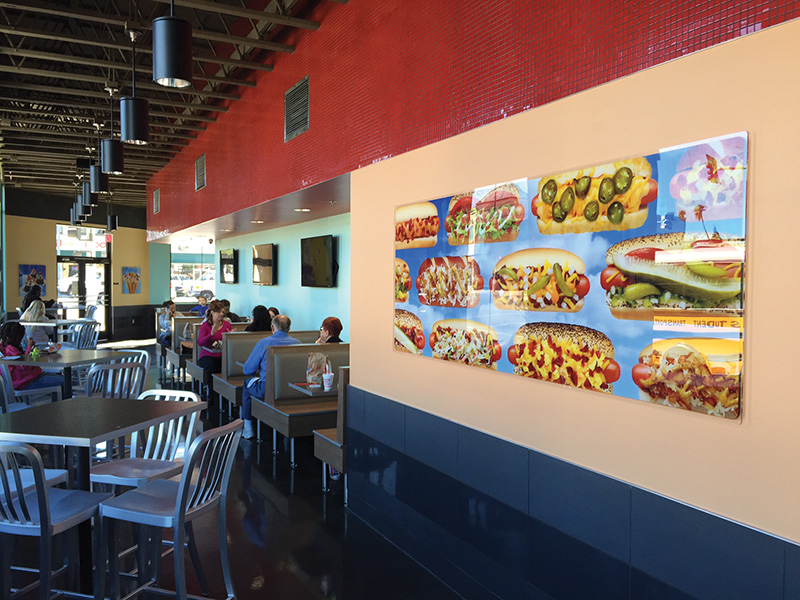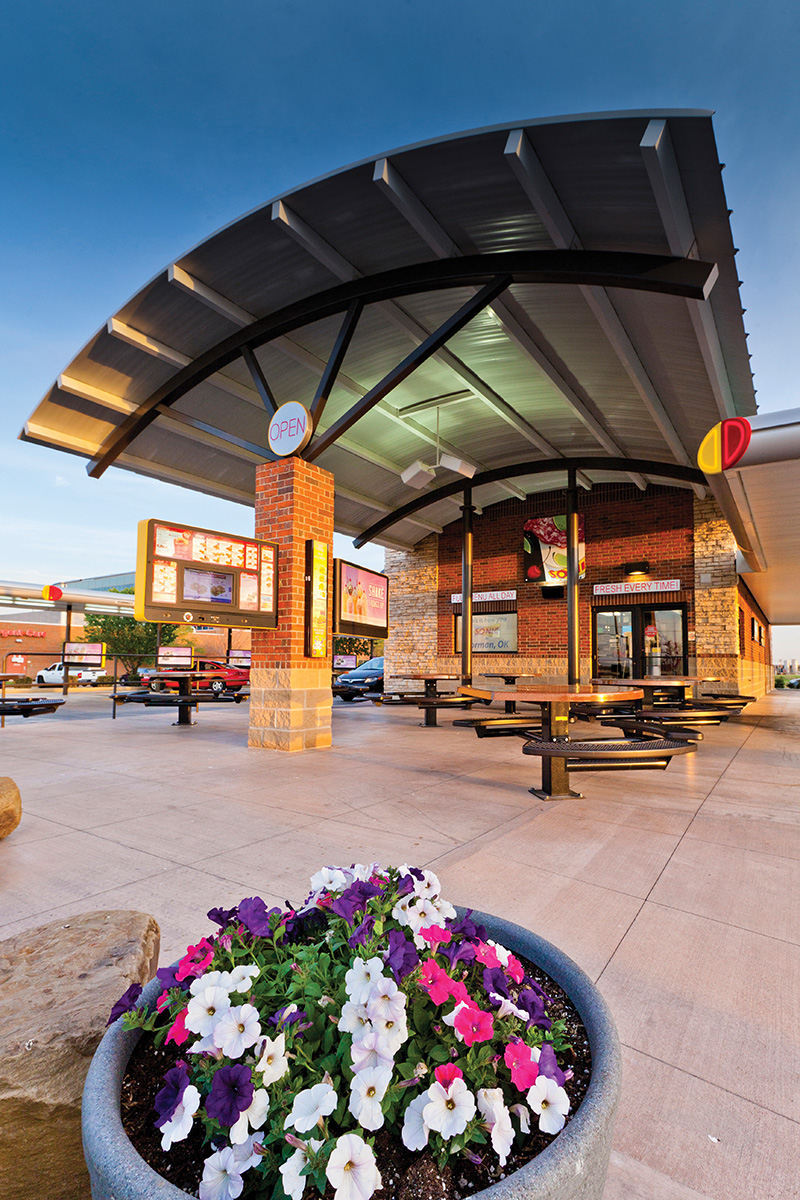SONIC plans to open 50-60 new drive-ins this year, including flexible design concepts like conversions from existing buildings.
Interview by Katie Lee
Flexible store design.” While many retailers and restaurants talk the talk, SONIC Drive-In actually walks the walk — beginning with site selection. SONIC has been busy buying existing assets and converting them: restoring older properties to match the modern SONIC look and feel, and layering in creative building design to transform failed businesses into profitable and thriving SONIC Drive-Ins. It’s flexible, it’s green, and it’s spurring rapid development for a company that already has more than 3,500 locations. Recently, Retail & Restaurant Facility Business interviewed Drew Ritger, senior vice president of development for SONIC, to learn more about the conversion process.
R&R: How many restaurants does SONIC operate today?
Drew Ritger: At the end of our fiscal year 2015, SONIC and its franchisees operated 3,526 drive-ins.
R&R: How many new locations opened in 2015, and what is the growth forecast for 2016?
 Ritger: During fiscal year 2015, 41 new SONIC Drive-Ins opened, and we are forecasting an additional 50 to 60 new drive-ins in fiscal year 2016.
Ritger: During fiscal year 2015, 41 new SONIC Drive-Ins opened, and we are forecasting an additional 50 to 60 new drive-ins in fiscal year 2016.
R&R: Tell me a little about the history of the company and why 2015 was a key year.
Ritger: SONIC traces its roots to 1953 when Troy Smith, Sr. bought the Top Hat root beer stand in Shawnee, Oklahoma. Back then, SONIC revolutionized the ordering process by using curbside speakers that allowed customers to place food orders without ever leaving their cars. This technology spawned the slogan “Service at the Speed of Sound™,” which translated to one word: SONIC. Troy aptly changed the name from Top Hat to SONIC Drive-In in 1959.
Every year is an important year for development. As SONIC continues to grow, we are expanding into new markets and identifying new areas of available territory for development. For example, in 2015, we entered our 45th state, Rhode Island. Since then, we have announced Hawaii as the 46th state as well.
 R&R: Please discuss the new store conversions. The largest SONIC to date opened earlier this year at 5,000 square feet near Buffalo, New York. It was a former Perkins restaurant/bakery. You have converted Wendy’s and Burger King locations, too. You’ve even converted some old banks. How many conversions has the company done so far and what’s the rollout plan in 2016?
R&R: Please discuss the new store conversions. The largest SONIC to date opened earlier this year at 5,000 square feet near Buffalo, New York. It was a former Perkins restaurant/bakery. You have converted Wendy’s and Burger King locations, too. You’ve even converted some old banks. How many conversions has the company done so far and what’s the rollout plan in 2016?
Ritger: SONIC is constantly working with franchisees to find building solutions that work for them and their resources, and many are finding success with building conversions. Franchisees are taking other buildings and modifying them to match the SONIC footprint and brand.
SONIC franchisees completed 22 conversions to date in California, Connecticut, Kansas, Nebraska, Ohio, Oregon, Massachusetts, Maryland, Rhode Island, South Carolina and Texas. A conversion model makes sense for SONIC if an existing property is located in a high-traffic area with rebranding potential. For example, we have had success with not only restaurant models but also banks and other types of retail properties that allow for a larger indoor dining area. This is especially useful in climates where indoor dining is in higher demand during extreme weather months.
In 2016, we expect to develop additional drive-in conversions. We support our franchisees in identifying appropriate real estate options for their new drive-ins and work with them in evaluating the appropriate building design.
R&R: What architectural, design and operational elements make conversions unique versus a full-scale remodel or new prototype?
Ritger: Converting an existing structure into a SONIC Drive-In offers many unique design opportunities that can help franchisees create a drive-in that matches the needs and desires of their community. For example, utilizing existing garage doors that allow the indoor dining room to be opened up when the weather is nice is an especially relevant drive-in experience for locations in warm climates, like San Diego.
R&R: How do conversions help reduce costs?
 Ritger: Conversions allow us to take advantage of existing resources and prime real estate. In many markets, open lots are hard to come by, but our franchisees can convert an unsuccessful concept location into a SONIC Drive-In and find success because of the unique dining experience and menu offerings we provide.
Ritger: Conversions allow us to take advantage of existing resources and prime real estate. In many markets, open lots are hard to come by, but our franchisees can convert an unsuccessful concept location into a SONIC Drive-In and find success because of the unique dining experience and menu offerings we provide.
Depending on the project, conversions may allow for faster development than ground-up projects. Every new drive-in situation is different, and we work closely with our franchisees to evaluate their options and identify the best solution for development.
R&R: How does back-of-house technology improve daily operations in the restaurants?
Ritger: Over the past few years we have streamlined our back-of-house technology to make running a drive-in simpler and more efficient. Specifically, we are working with new POS systems now that enable drive-in management to better monitor and control many aspects of the drive-in; from supply ordering, to staffing and profitability.
R&R: What kind of feedback are you getting from franchisees about the conversions? And from customers?
Ritger: Franchisees may opt for a conversion for a variety of reasons. First, a conversion may mean lower investment costs in some cases, as they may have faster permitting times and a shorter construction cycle.
Additionally, franchisees like the flexibility of location when it comes to crowded markets. A SONIC franchisee can convert an unsuccessful QSR concept in a prime location and be successful.
Finally, franchisees who opt for conversions have an opportunity to put the SONIC spin on an existing structure, allowing for a bit more architectural creativity and flexibility to meet community needs.
Guests are enjoying our conversions, as many of the newly converted SONIC Drive-Ins have received warm welcomes from their communities.
 R&R: What is the new typical square footage of a SONIC, or is there a wide range depending on the space they go into?
R&R: What is the new typical square footage of a SONIC, or is there a wide range depending on the space they go into?
Ritger: There are a few different SONIC Drive-In prototypes available, with a range of square footage depending on the site location and community fit. We focus on lot square footage given our unique drive-in format, and depending on the model, the average lot size is about 28,000 square feet.
R&R: Are there any “green” elements about the restaurant’s design and construction (sustainable materials, energy-efficient fixtures, etc.)?
Ritger: SONIC is testing solar panels at a company-owned location in San Antonio, Texas, and three SONIC franchise groups located in three states (Tennessee, Colorado and Oregon) that already have solar panels are experiencing savings while reducing dependency on the power grid. SONIC’s unique drive-in model provides a creative and effective way to install solar panels on the canopies above the drive-in stalls, utilizing unused space and eliminating the need to squeeze panels onto the building’s rooftop. The SONIC canopies are a custom fit and an ideal design for a solar panel concept, optimizing the drive-in’s access to solar power.
R&R: Staying on the green theme, you mentioned SONIC is currently piloting a few different things, including LED lights, solar panels and electric vehicle charging stations. Can you tell us about those programs?
Ritger: SONIC is testing energy-efficient solutions, including solar panels, LED lighting and electric vehicle charging stations.
As previously mentioned, there are three SONIC franchise groups in three states that have solar panels. As a franchise-centric brand, SONIC gives franchisees the flexibility and autonomy to explore these and other energy- and cost-saving options. In addition, SONIC recently began a pilot of solar panels at a company-owned location in San Antonio to reduce energy costs; this is the first company-owned location to pilot solar panels.
SONIC is currently in the process of upgrading all company-owned drive-ins to LED lighting with the objective of saving $500 to $1,000 in energy cost per drive-in per year. Company-owned drive-ins have already received more than $100,000 in rebates for switching to LED lighting.
SONIC is also piloting electric vehicle chargers in two locations: one in Boerne, Texas, and one in Westminster, Colorado. Electric vehicle chargers represent another way SONIC is working to become a more energy-efficient brand that adapts to new technology and guest needs.
R&R: What incentivizes SONIC to participate in green programs such as solar panels and EV charging stations?
Ritger: SONIC is investing in these technologies because it positively impacts the bottom line. For example, LED lighting options offer the potential for savings, higher quality lighting, reduced repair and reduced maintenance, in addition to the rebates that are offered. Testing energy-efficient solutions now will set up our company-owned drive-ins and our franchisees for more financial savings and therefore more financial success down the road.
R&R: How has the ROI been on your LED program so far?
Ritger: Company-owned drive-ins already have received more than $100,000 in rebates for switching to LED lighting.
R&R: Describe how SONIC handles repair and maintenance. Do you have an in-house maintenance department or do you rely on vendors? Or do franchisees handle R&M individually?
Ritger: We use both local and national vendors to support our R&M program. Our company-owned drive-ins are provided a vendor contact list, and, in most cases, they have a primary and secondary vendor that they use. These vendors are typically vetted by the facilities team.
Our franchisees handle R&M on their own, with guidance from the corporate office. Some of our larger franchisees have technicians on staff, but the majority use outside vendors.
R&R: Do you use local or national vendors? Why?
Ritger: We use both local and national vendors. Typically, using local vendors means a quicker response time. In some cases, we use national facility vendors such as roofing, door & glass repairs, HVAC, electrical and more. The advantage to including national vendors is consistency when a specific service is needed across the system.
R&R: By what criteria do you choose your R&M vendors?
Ritger: We vet all of our R&M vendors in several ways; references from competitors, years in business, area of coverage, specific services offered, performance, financial strength, number of technicians available, and more. We have sourced national facility vendors from RFMA (Restaurant Facility Management Association).
R&R: What do you enjoy most about your job day to day?
Ritger: I enjoy having the opportunity to create value for our franchisees and company partners while bringing the SONIC brand to a community. It is exciting to be part of such a great brand with so many wonderful people who are second to none in their passion for the brand.
R&R: What goals have you set for your team, short term and long? Five years from now?
Ritger: We are currently working with our franchisees to test new ways to be more energy-efficient so we can help them save wherever we can. We are making progress thoughtfully to ensure we are considering the right kinds of solutions for long term benefits.
One of our major goals is to create the best small business in America while bringing opportunities to thousands of people across the country. We plan to expand into all 50 states, and with our recent announcement of entering Hawaii, our 46th state, we are close to reaching that long term goal.
— This article originally appeared as the September 2016 cover story of Retail & Restaurant Facility Business. Email the editor at [email protected].
